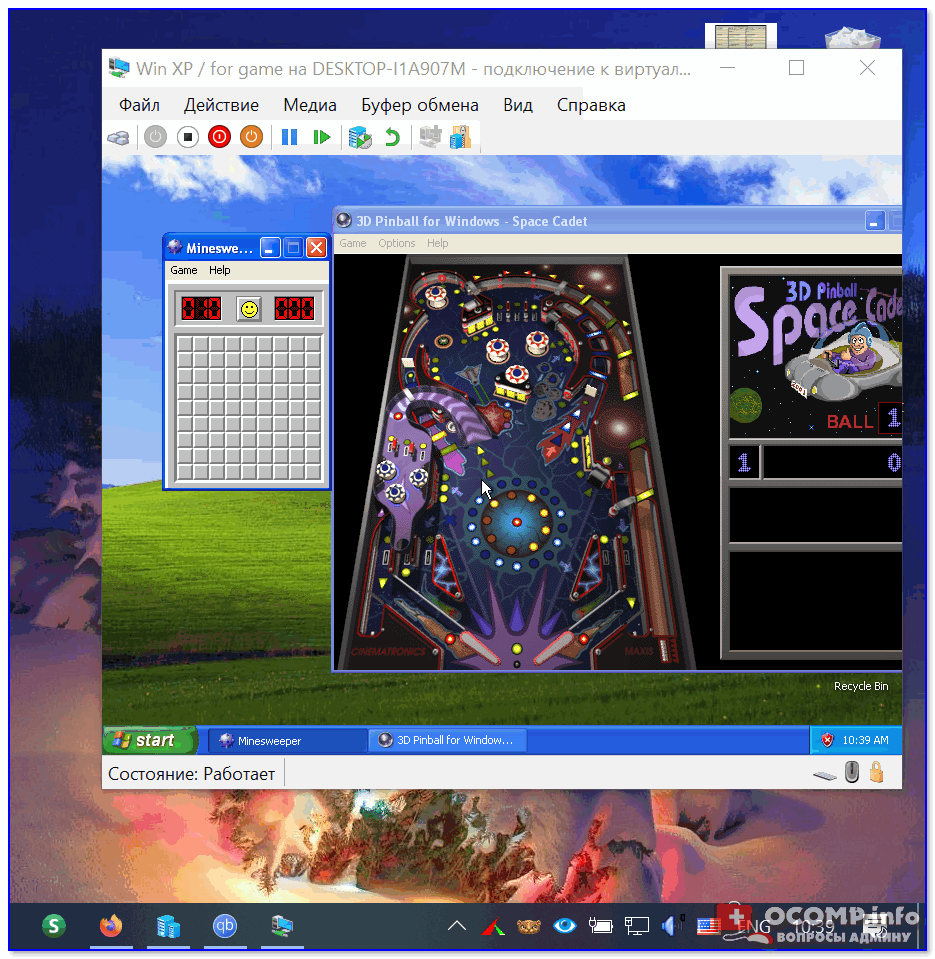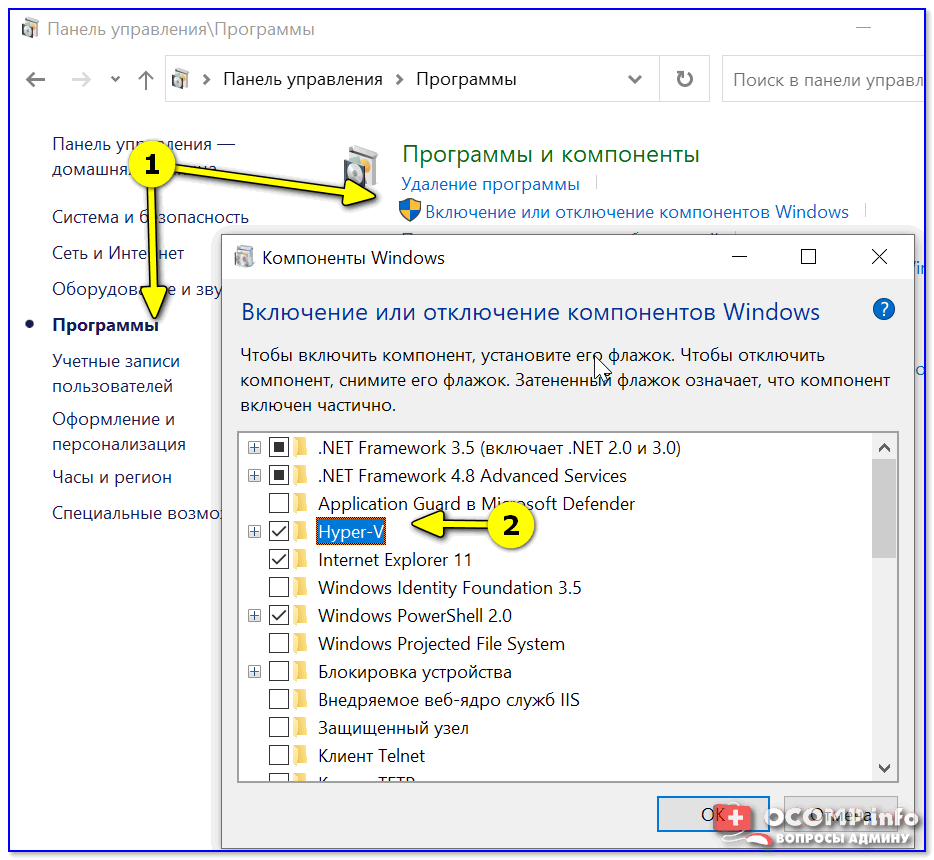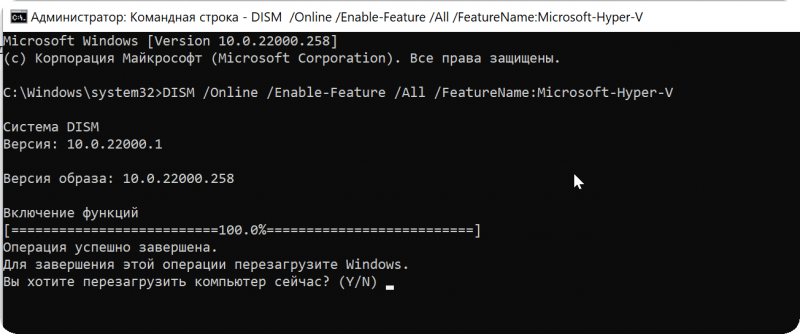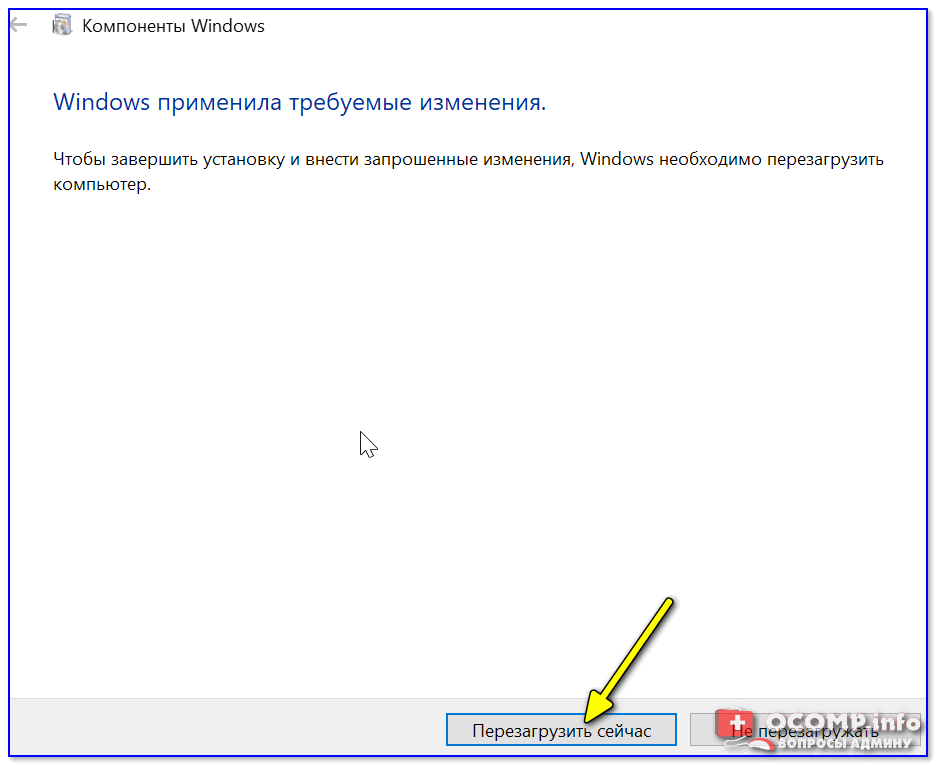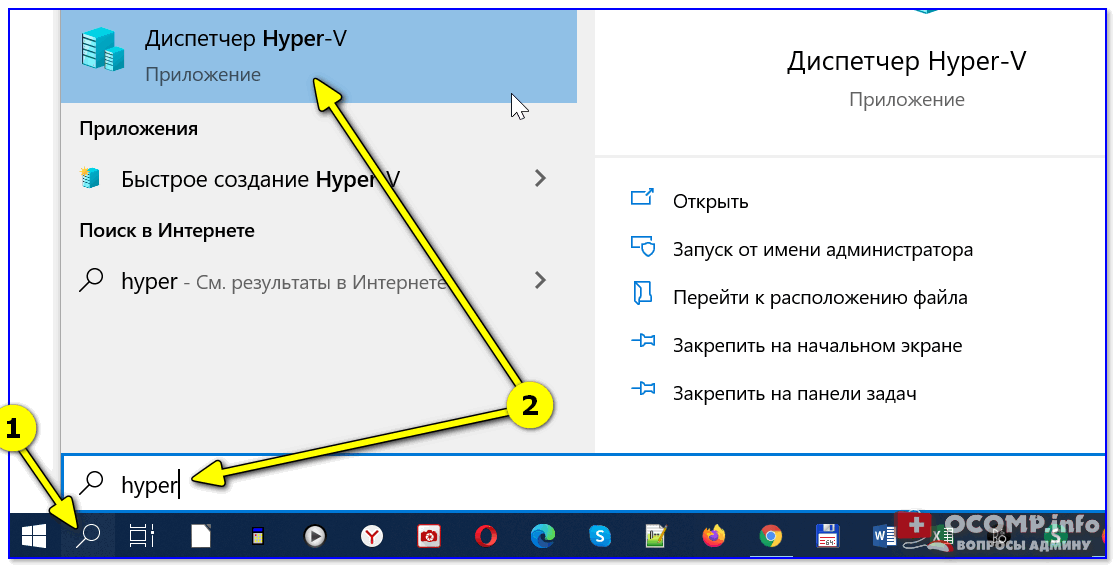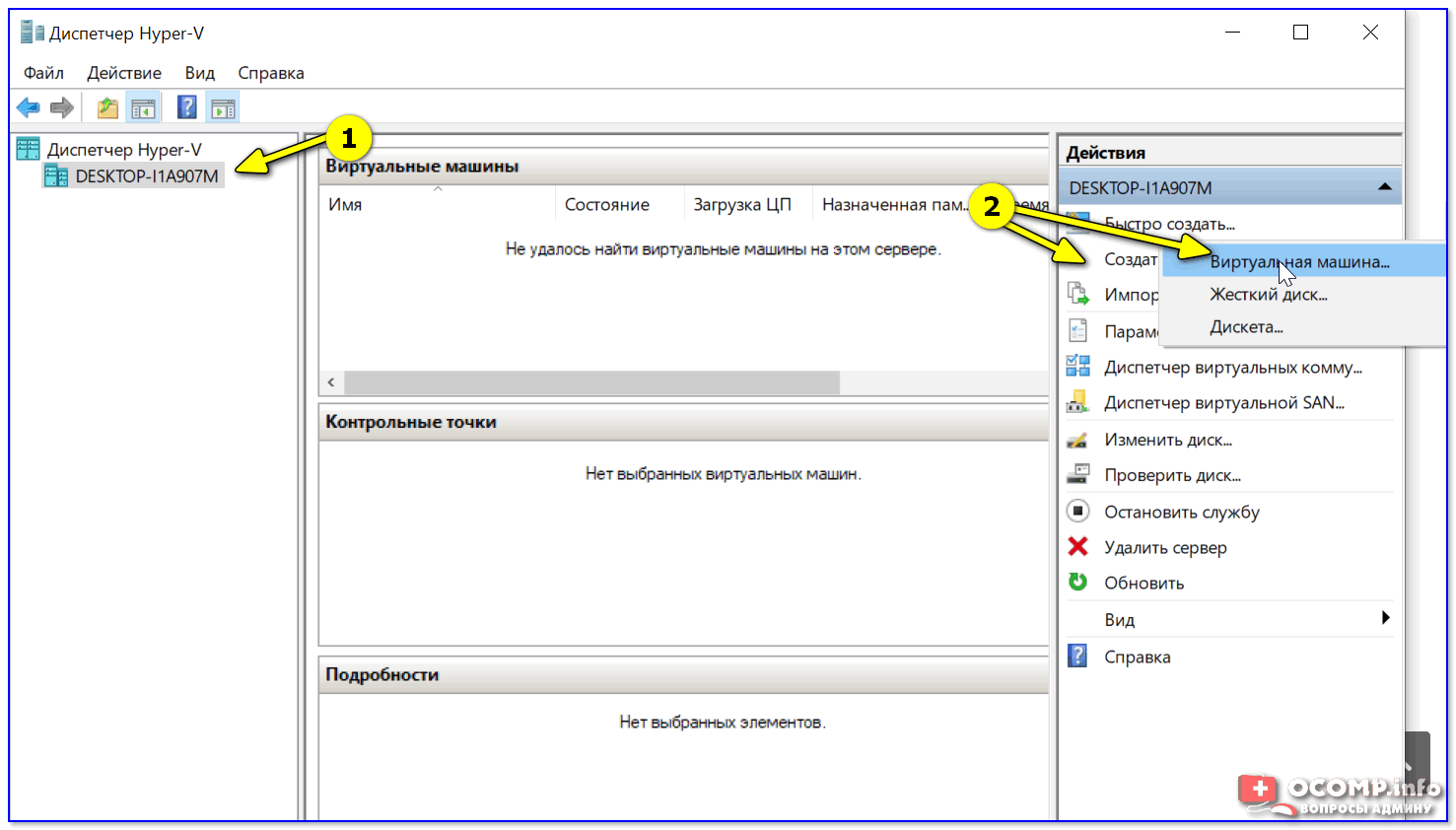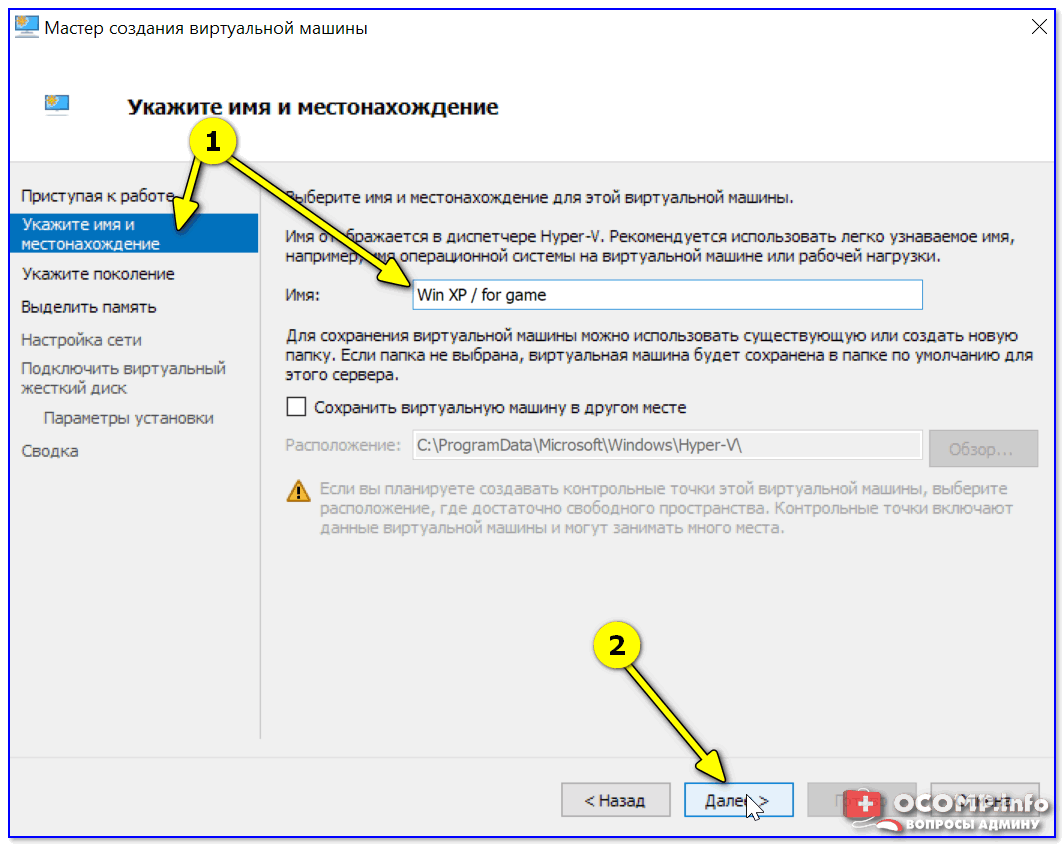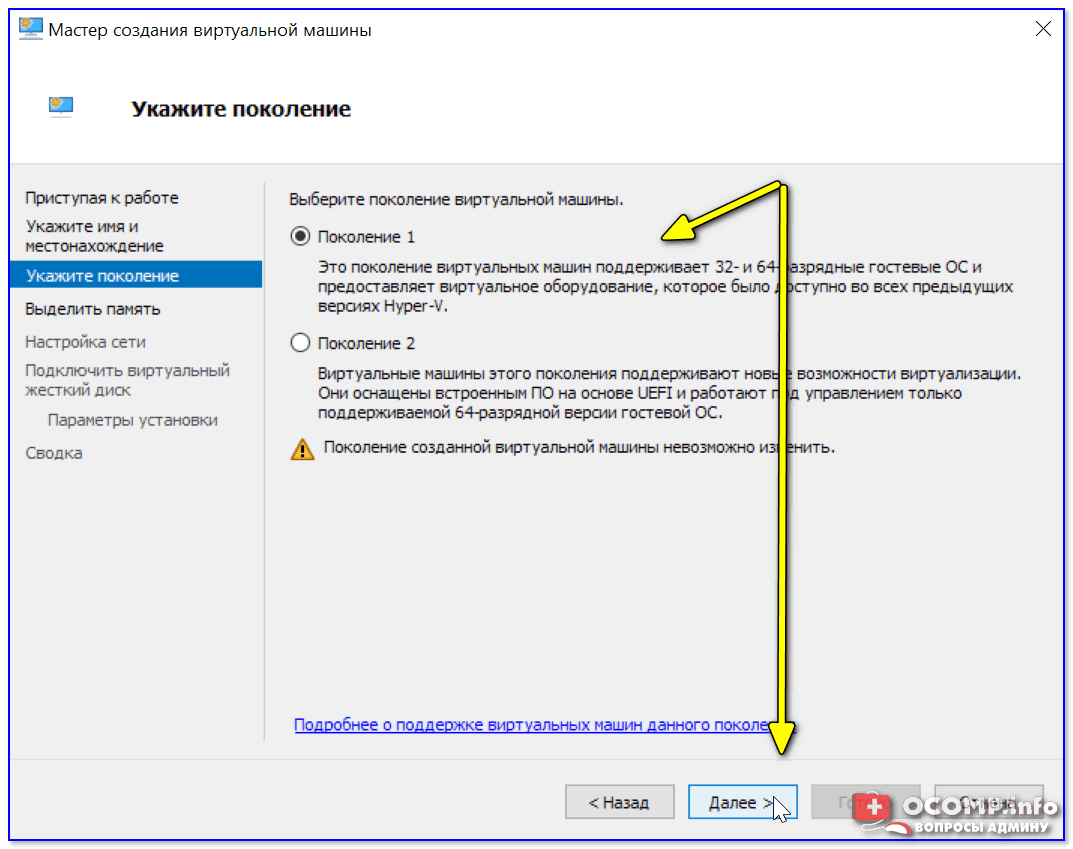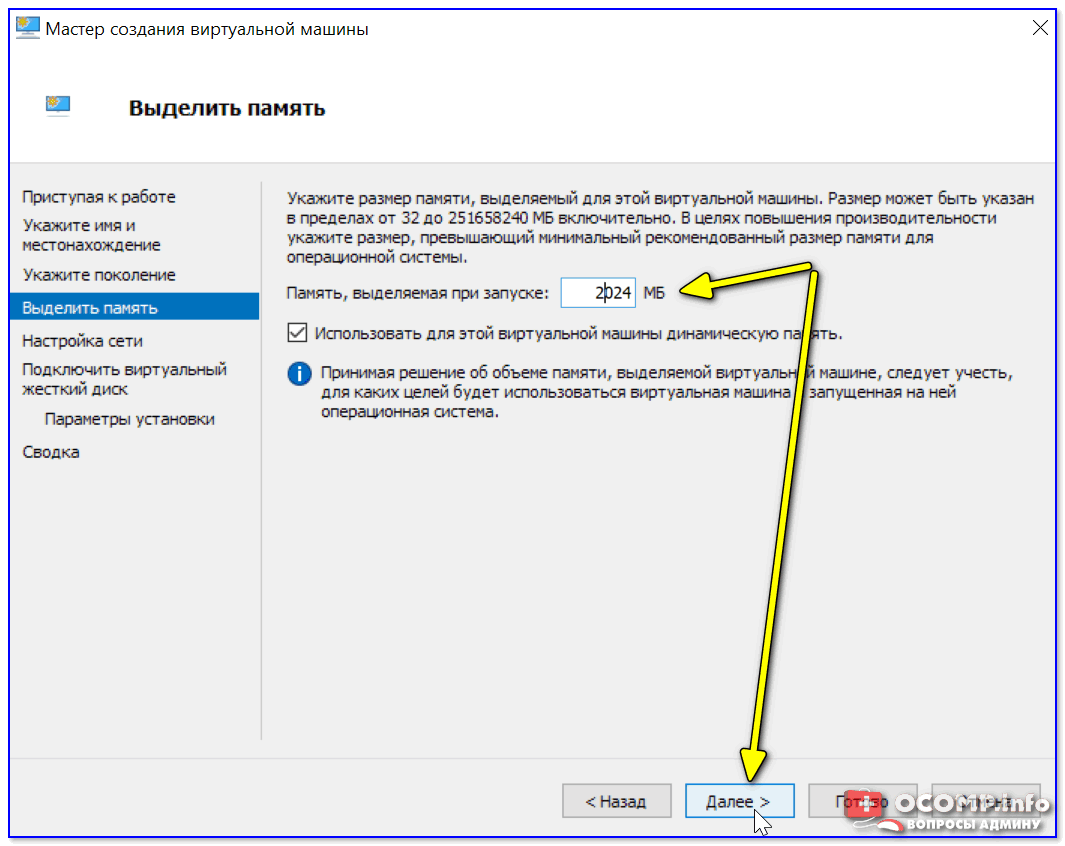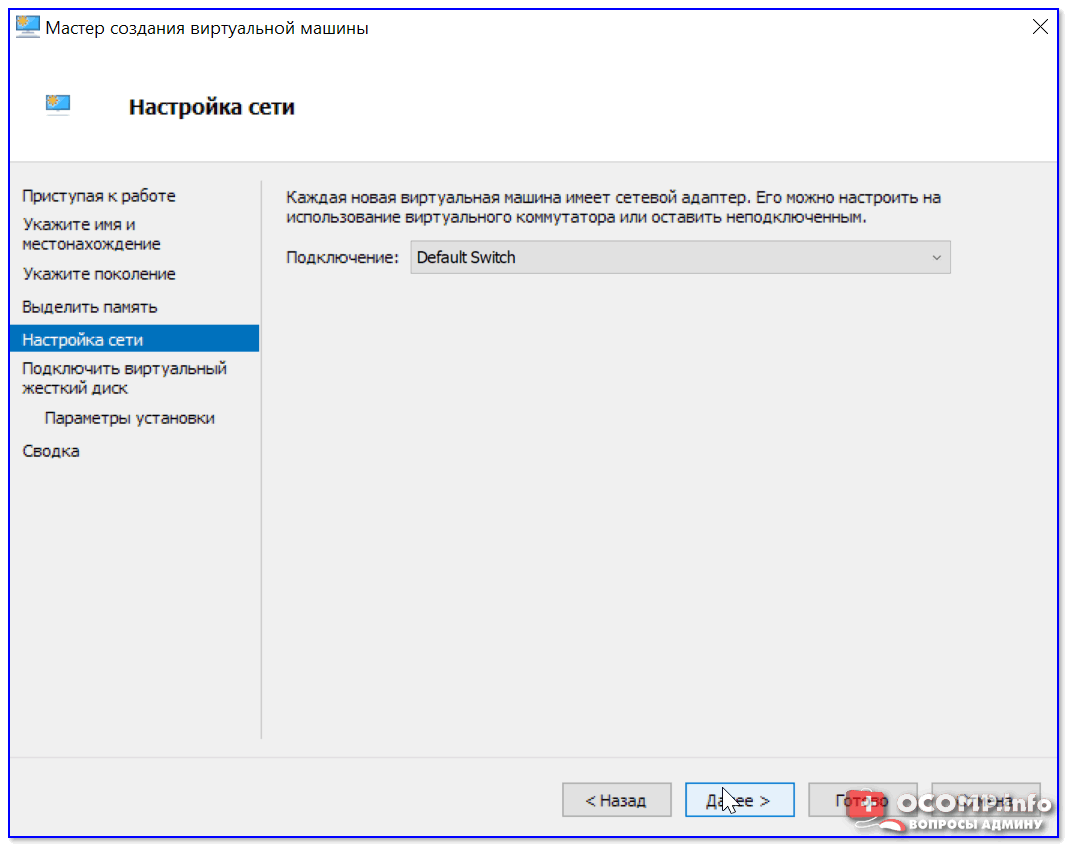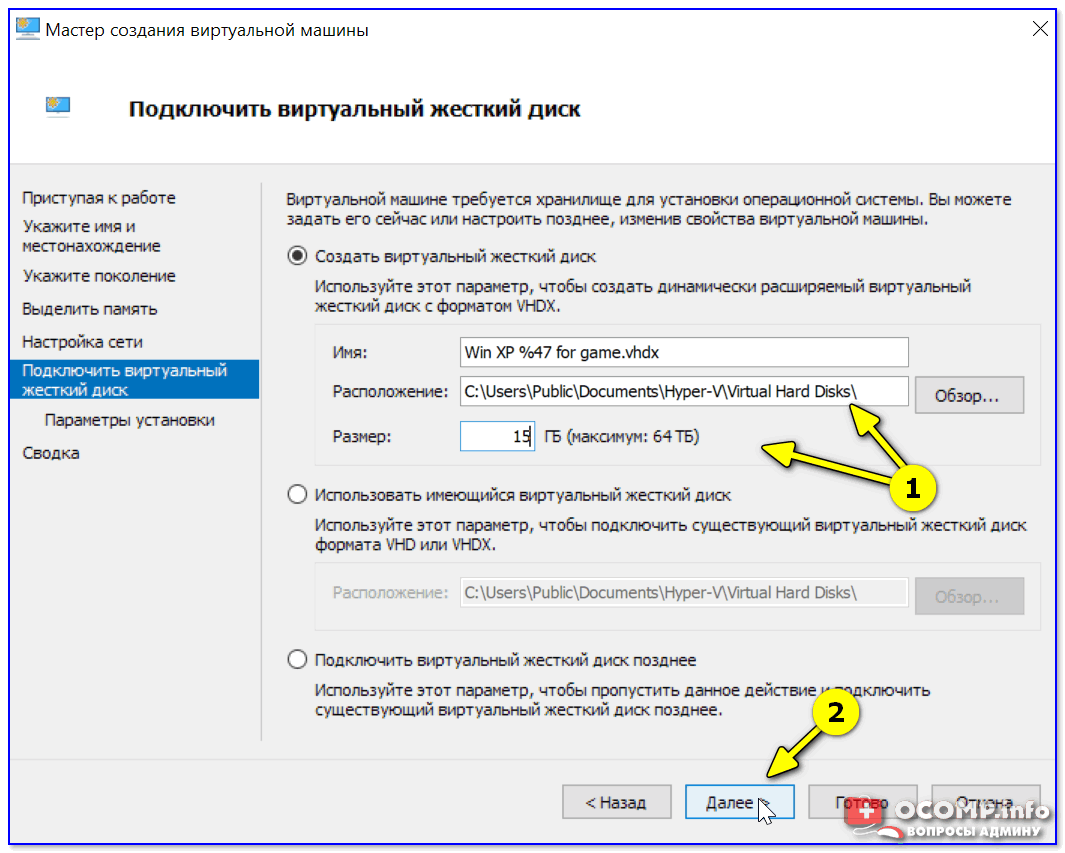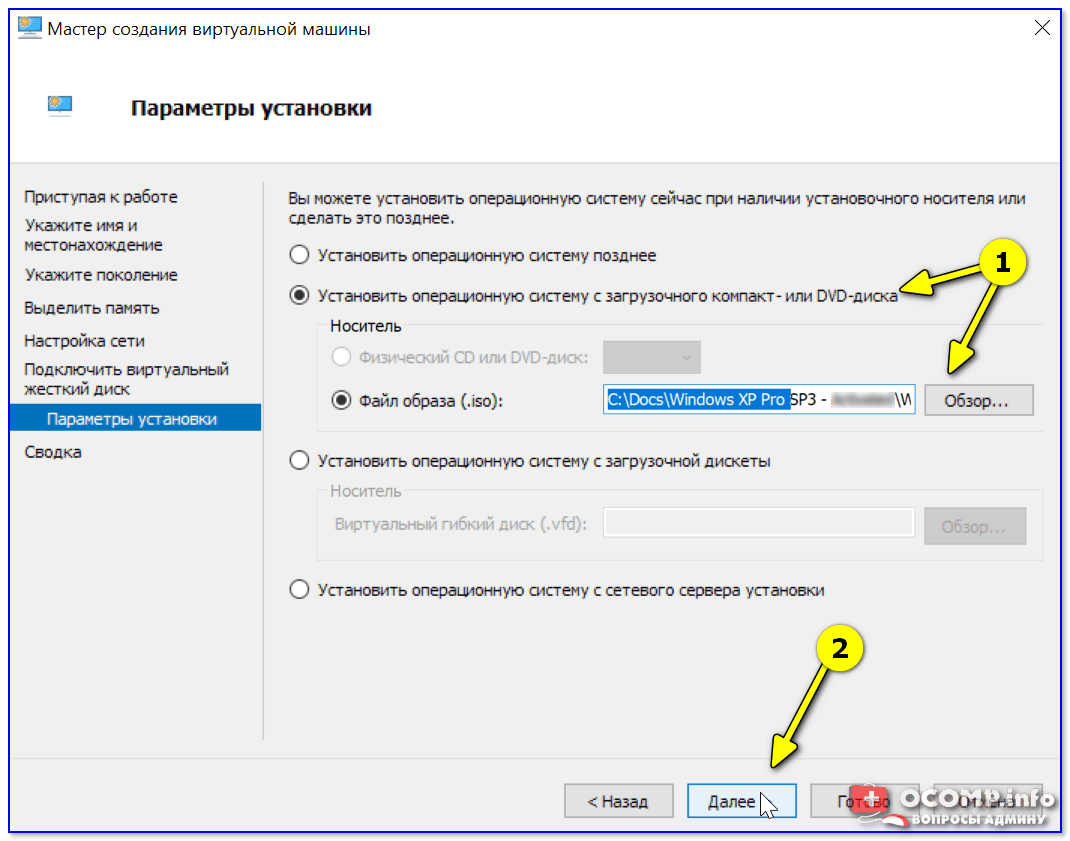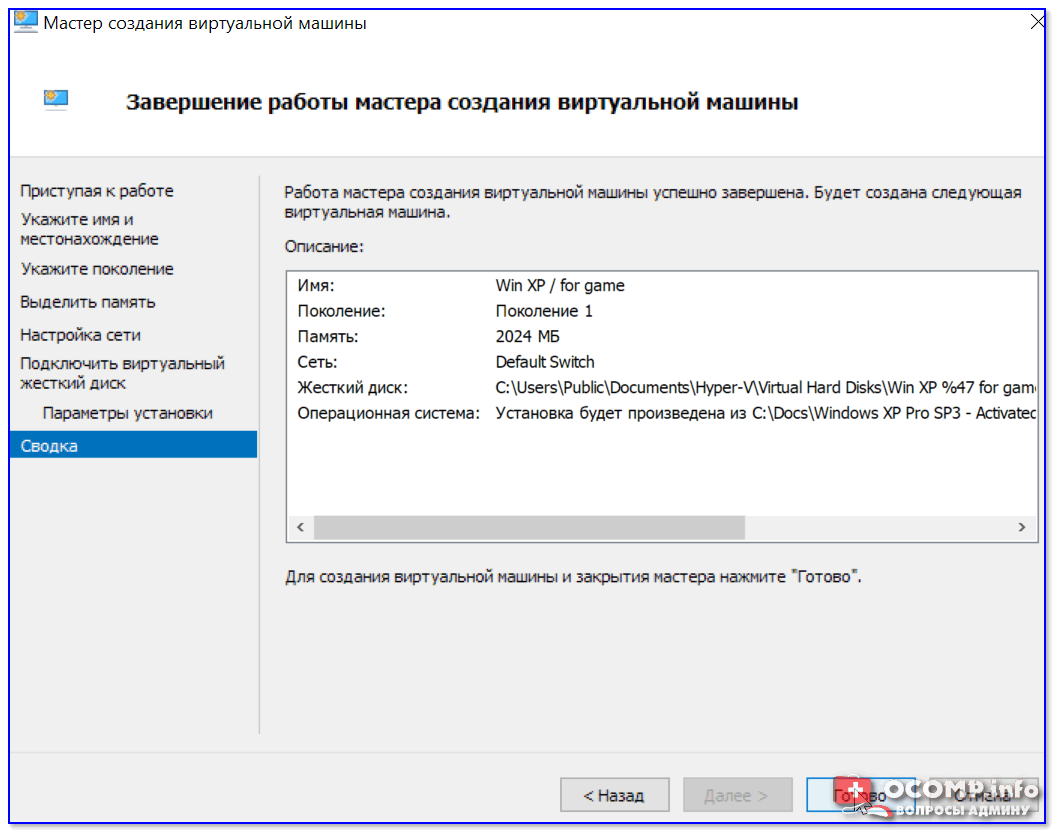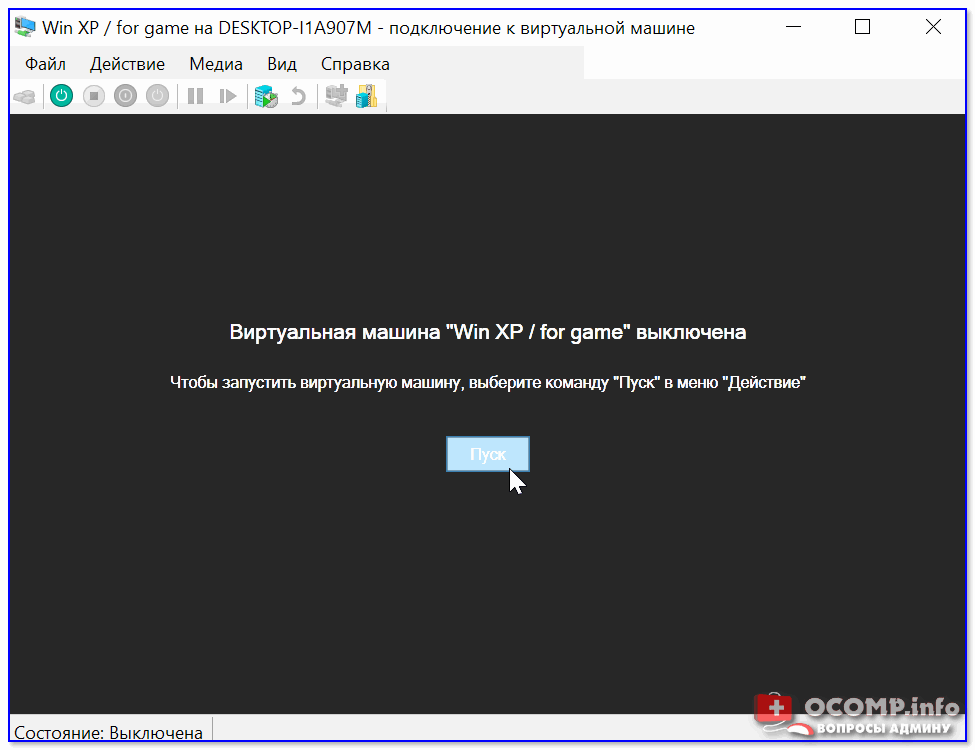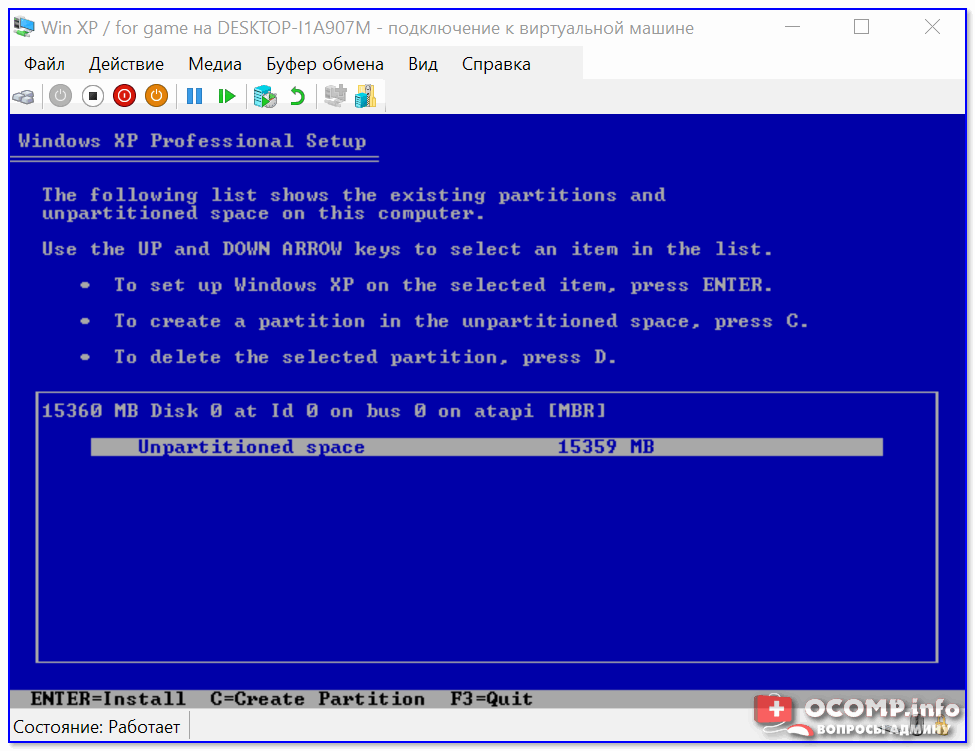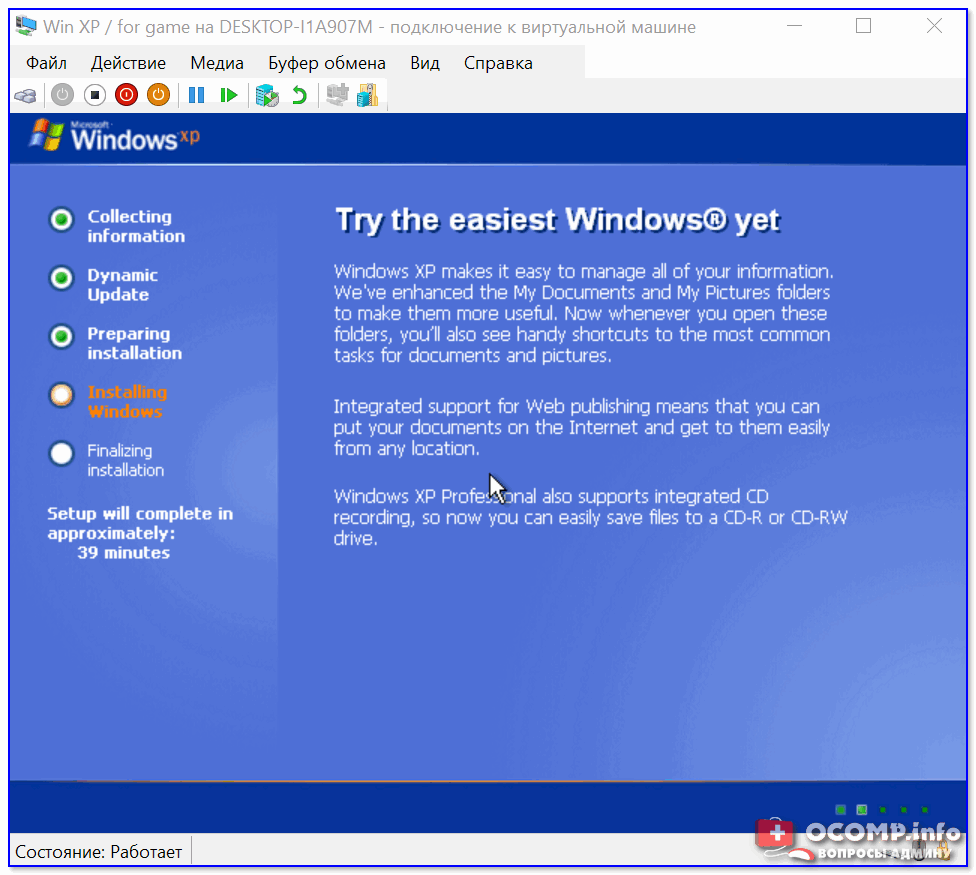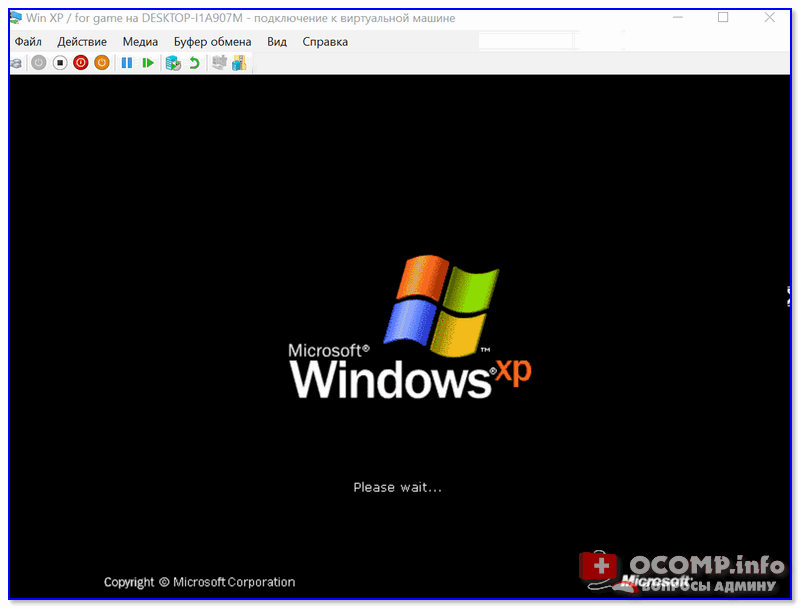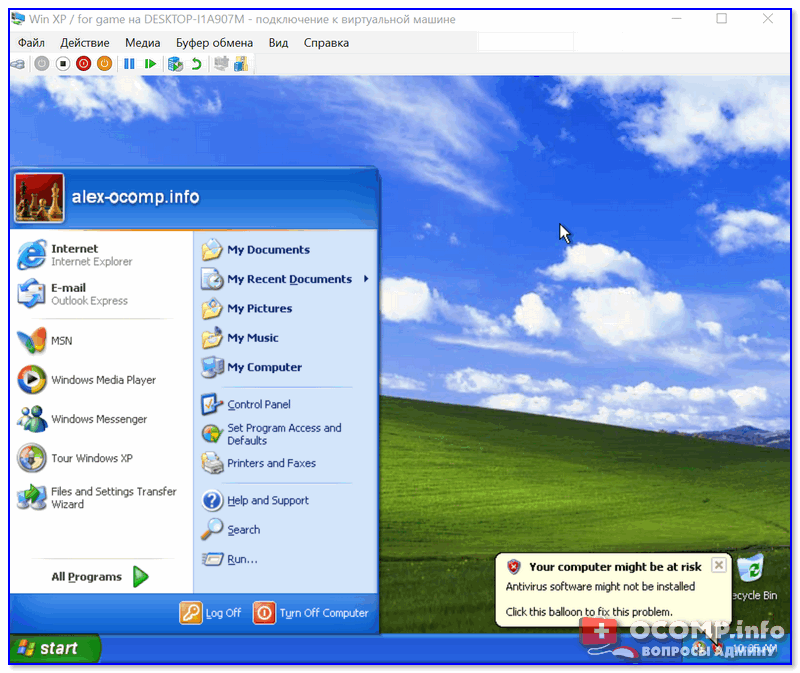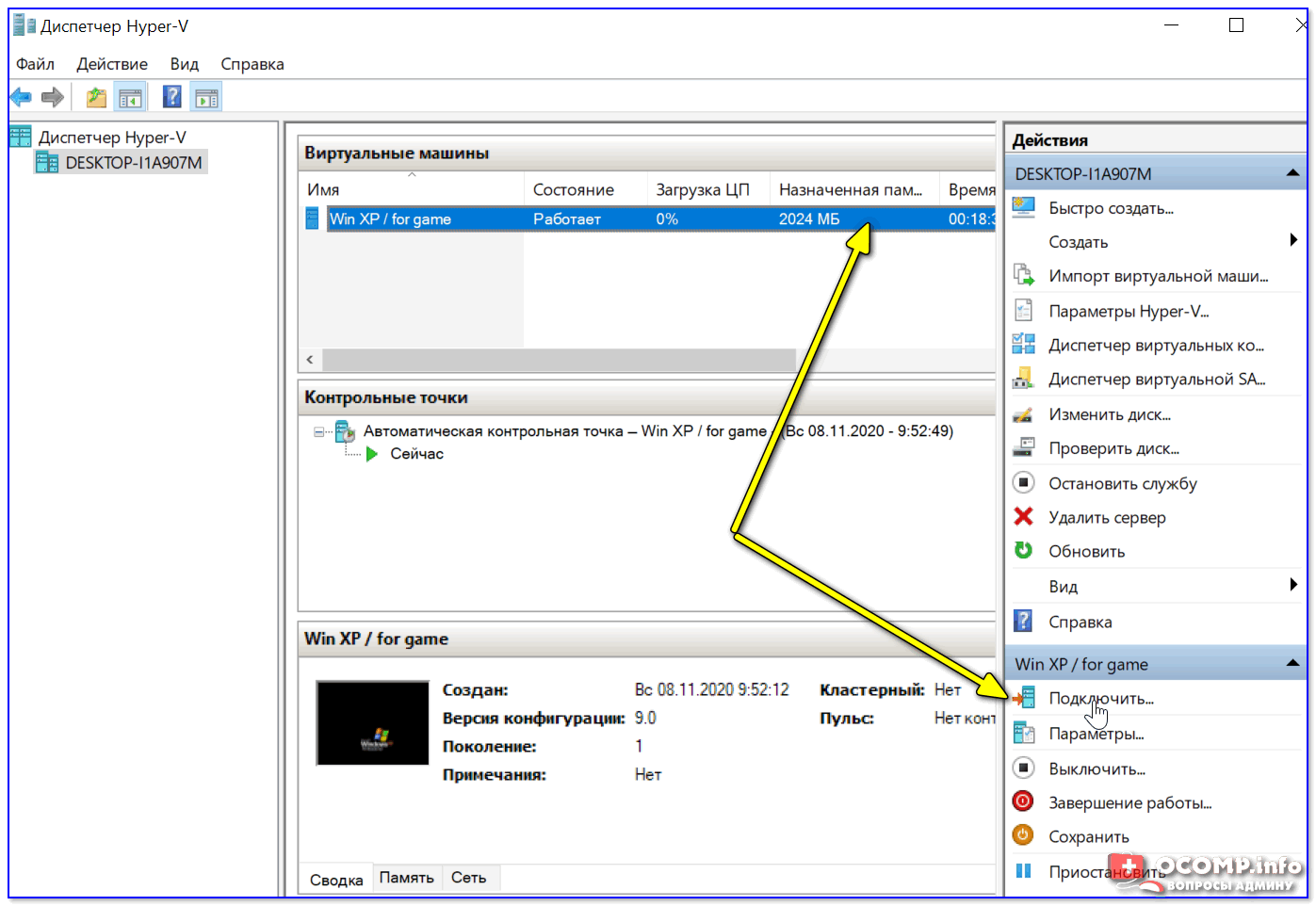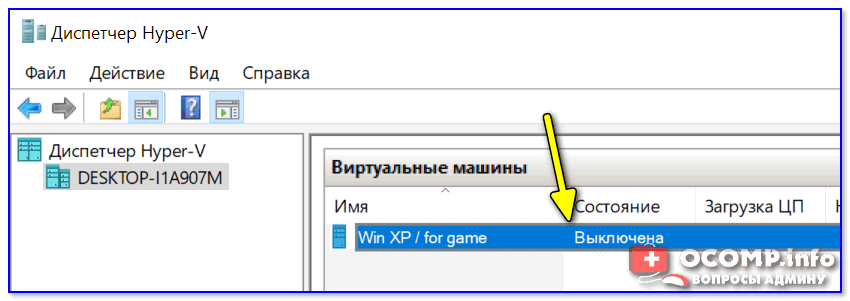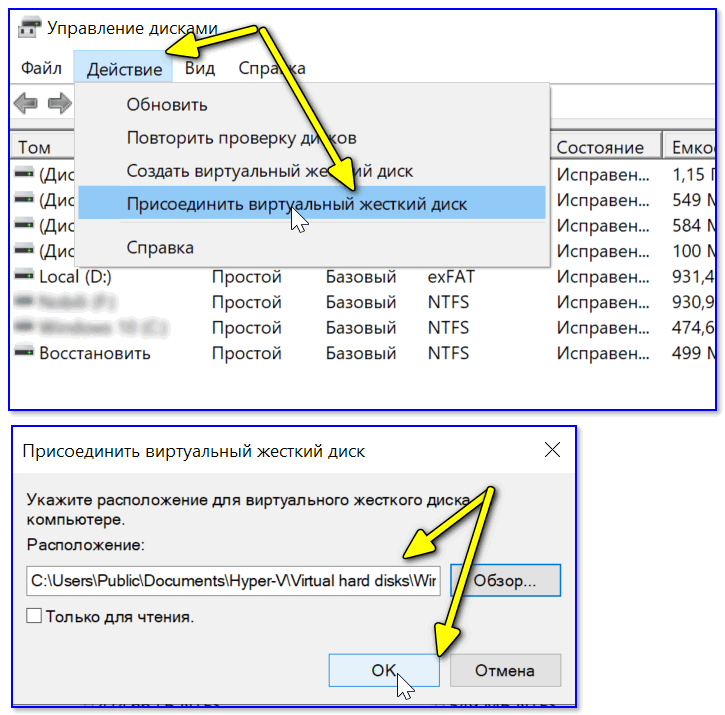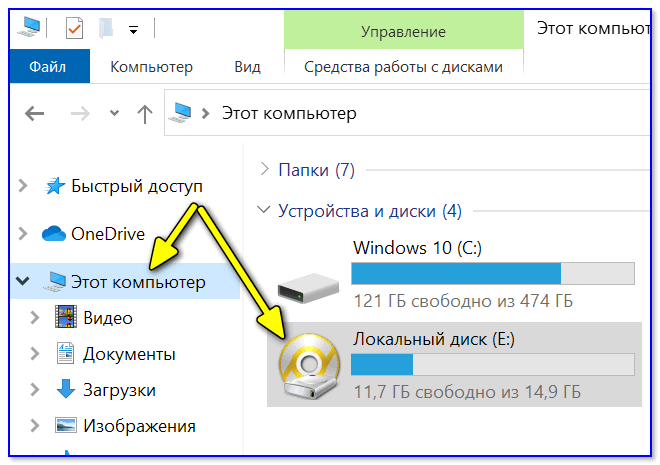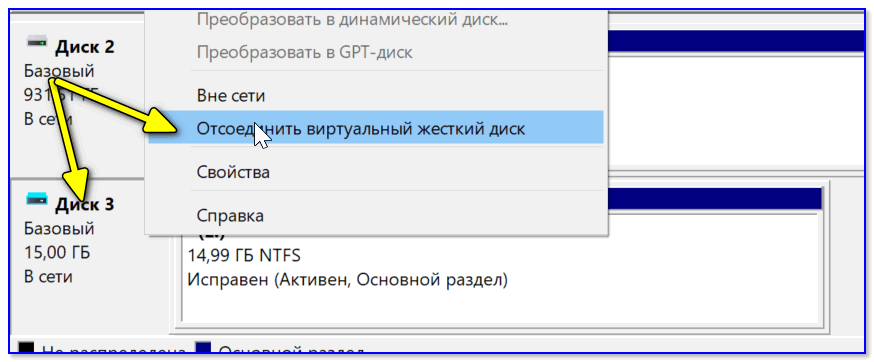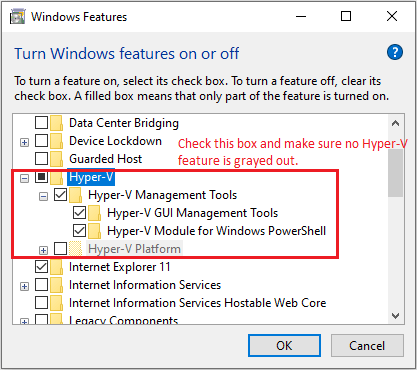Установка на Hyper V Windows XP ничем не отличается от других только тем, что мы используем первое поколение виртуальных машин и в каких-то случаях требуется установка пакета интеграции Hyper V содержащие драйвера для старых ОС.
Есть небольшие требования к установке Windows XP на Hyper V:
- Мы должны использовать тип Generation 1 к установке виртуальной машины.
- Динамическая память должна быть отключена.
- Версия Windows XP Home не будет работать в рамках виртуальной машины. Нужно использовать версию Pro.
- В рамках установки нужно использовать 1 или 2 Гб оперативной памяти. После установки можно увеличить.
- Во время установки не используйте более 2 виртуальных процессоров.
- Для операционных систем выше Windows Server 2012 r2 и Windows 10 потребуется дополнительная настройка в виде установки драйверов.
Версии Windows 10 и 2016 не поставляются с нужными драйверами для мышки, аудио и сети. Что бы исправить эту ситуацию нужно устанавливать пакет интеграции Hyper V. О том как установить отсутствующие драйвера и службы интеграции Hyper V рассмотрим далее.
Если вы планируете что у виртуальной машины будет доступ к интернету нужно создать коммутатор. Более подробно о виртуальных коммутаторах Hyper V мы уже говорили. Для этого нужно открыть диспетчер коммутаторов:
Далее создать внешний виртуальный коммутатор:
Рекомендую установить название и оставить галочку на «Разрешить управляющей операционной системе предоставлять общий доступ к этому сетевому адаптеру» (иначе вы потеряете доступ к сети):
Может появится сообщение, которое предупредит, что соединение с интернетом может быть прервано. Это продлится несколько секунд, после чего начнем создание виртуальной машины Hyper V:
Мы увидим стартовое окно, его можно пропустить. В следующем окне стоит указать имя виртуальной машины и, если необходимо, изменить место где будут храниться конфигурация виртуальной машины (не диск):
В этом окне выбирается тип виртуальной машины. Для Windows XP в Hyper V используется первый тип вне зависимости от разрядности операционной системы. Эта настройка выбирается единожды и в последующем ее нельзя изменить:
В этом окне выбирается размер оперативной памяти и возможность использования динамической памяти. Фиксированная память — эта та часть, которая будет зарезервирована виртуальной машиной. Динамическая память не поддерживается Windows XP и ее выбирать не стоит. Для Win XP в Hyper V вполне достаточно и 2ГБ оперативной памяти, но можно поставить и меньше:
На этом шаге можно выбрать коммутатор, который мы создавали ранее. Этого не стоит делать так как в этом окне создается сетевой адаптер для виртуальных машин поколения 2, а нам нужен синтетический адаптер, который мы создадим позже:
В окне создания дисков Hyper V выбирается имя виртуального диска, его местоположение и размер. Я бы советовал указать имя, что бы в дальнейшем не путаться, а так же указать размер. Для Windows XP достаточно 10 ГБ, если вы не планируете устанавливать на нее большие программы:
В этом окне выбирается образ для установки Windows XP:
В финальном окне и еще раз проверяем, что все данные введены верно и завершаем создание виртуальной машины:
Теперь создадим синтетический адаптер, с помощью которого мы сможем выходить в интернет с этой виртуальной машины. Откройте настройки виртуальной машины:
Во вкладке добавления устройств нужно выбрать синтетический адаптер и добавить его:
Выберем синтетический адаптер и подключим к созданному ранее коммутатору:

Установка Windows XP обычная и она не будет рассматриваться.
После установки, скорее всего вы столкнетесь с трудностями в виде отсутствия драйверов к мышке, аудио и сети если работаете на Windows 10 или Windows Server 2016. Дело в том, что ранее, в версии до Windows 8 и Windows Server 2012 r2 входил такой файл интеграции vmguest.iso, который содержал в себе драйвера для устройств. Он лежал по пути ‘C:Windowssystem32’. В более новые версии Hyper V он не входит и есть два варианта обхода этой ситуации:
- Скачать ОС с Hyper V старых версий и достать этот файл с пакетом интеграции и драйверами оттуда
- Скачать vmguest.iso с нашего сайта.
Теперь мы должны вставить этот файл в привод:
Если в вашей версии Win XP стоит автозапуск файлов с DVD привода, то пакет интеграции установится автоматически и вы сможете нормально пользоваться ОС. Если автозапуск отключен, то откройте через горячие кнопки Win+E проводник и с помощью TAB выберете и запустите файлы с привода.
После установки сервисов интеграции у нас могут остаться несколько неопознанных устройств с отсутствующими драйверами:
- vmbus{4487b255-b88c-403f-bb51-d1f69cf17f87}
- vmbus{3375baf4-9e15-4b30-b765-67acb10d607b}
- vmbus{99221fa0-24ad-11e2-be98-001aa01bbf6e}
- vmbus{f8e65716-3cb3-4a06-9a60-1889c5cccab5}
Эти драйвера связаны с устройствами AVMA — возможностью автоматической активации, которая появилась в версиях 2012 R2 и соответственно не поддерживается в более ранних версиях.
Мы не можем использовать возможность копирования и вставки файлов через Hyper V с Win XP. Если есть необходимость копирования больших файлов используйте эти варианты:
- С помощью RDP подключения, которое позволяет переносить файлы через копировать/вставить
- Если не хотите нагружать сеть, то можете создать частный коммутатор и переносить данные через него. Это так же включает возможность использовать RDP.
- Выключайте виртуальную машину и монтируйте VHD файл через диспетчер дисков. Затем скопируйте данные и не забудьте размонтировать диск во избежании проблем с виртуальной машиной.
…
Теги:
#hyper-v
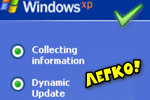
Оказывается в некоторых учебных заведениях еще используют Windows XP и делают на них лабораторные работы 👀. Собственно, именно по этой причине — одни знакомые попросили меня как-нибудь запустить старый софт в новой Windows 10 (11).
Как вариант решения: решил установить им виртуальную машину с Windows XP, на которой лабораторные будут «работать» (благо, что в Windows 10/11 есть встроенное средство гипервизор Hyper-V, а значит качать дополнительно ничего не нужно!). Да и пользоваться им достаточно просто… 👌
В общем, ниже покажу на пошаговом примере как можно создать себе виртуальную «Windows», и пользоваться ей, как обычной программой (запуская в окне).
Возможно, это кого-то убережет от покупки старого ноутбука/ПК для учебы (или для запуска старых игр 😉).
*
Примечание: всё, что описано ниже — можно сделать на 📌ОС Windows 10/11! Для норм. работы Hyper-V необходимо не менее 6 ГБ ОЗУ и 64-разрядный процессор (с аппаратной 📌виртуализацией // проверьте, чтобы она была у вас включена!). Вообще, ее сейчас поддерживают все современные ЦП…
*
📌Важно!
Если вам нужна виртуальная Windows XP (например), чтобы подключать к ней старые принтеры, сканеры и пр. — то рекомендую остановить свой выбор на VirtualBOX. Более подробно по этой теме тут.
*
Что у нас получится в итоге — виртуальная Windows XP запущена в Windows 10 (аппаратная виртуализация в Windows 10)
*
Содержание статьи
- 1 Создание виртуальной «Windows»
- 1.1 ШАГ 1: включаем компонент Hyper-V, и запускаем диспетчер
- 1.2 ШАГ 2: создание виртуальной машины (ВМ)
- 1.3 ШАГ 3: установка Windows на ВМ
- 1.4 ШАГ 4: использование ВМ
- 1.4.1 Как скопировать файлы на диск ВМ
→ Задать вопрос | дополнить
Создание виртуальной «Windows»
ШАГ 1: включаем компонент Hyper-V, и запускаем диспетчер
Итак, сначала необходимо установить компонент Hyper-V (по умолчанию в Windows он выключен). 📌Сразу предупрежу, что в домашних версиях Windows — этот компонент установить нельзя! В этом случае вам нужно сначала перейти на Pro версию ОС // для этого, как правило, необходимо поменять ключ активации и обновить ОС).
*
Наиболее простой способ «задействовать» Hyper-V — воспользоваться вкладкой «Включение или отключение компонентов» в панели управления Windows.
*
Чтобы открыть ее — можно нажать Win+R, и воспользоваться командой optionalfeatures (либо зайти в 👉 панель управления Windows и открыть раздел «Программы», см. скрин ниже 👇).
В ней нам требуется поставить галочку напротив пункта «Hyper-V» и нажать OK.
Как установить Hyper-V
Кстати, установить диспетчер Hyper-V в Windows 10/11 можно и другим способом — запустить командную строку от имени динистора и использовать команду:
DISM /Online /Enable-Feature /All /FeatureName:Microsoft-Hyper-V
Важно: обязательно согласиться на перезагрузку, выбрав вариант «Y». 👇
Включение Hyper-V в командной строке
Во время перезагрузки компьютера произойдет до-установка нужного нам компонента. 👌
Перезагрузить сейчас
*
📌Запустить диспетчер Hyper-V (если у вас уже установлен этот компонент) достаточно просто:
- можно нажать Win+R, и использовать команду virtmgmt.msc;
- либо можно набрать в поиске «Hyper-V» и запустить «диспетчер Hyper-V». И тот, и другой вариант — должны работать! 👌
Запуск Hyper-V
*
ШАГ 2: создание виртуальной машины (ВМ)
После первого запуска диспетчера Hyper-V — у вас никаких виртуальных машин (далее просто «ВМ») быть не должно.
Чтобы создать ВМ — обратите внимание на вкладку «Действия» (в колонке справа 👇). Кликните по кнопке «Создать» как у меня на скриншоте.
Диспетчер Hyper-V — создать
Далее необходимо придумать имя для ВМ. Можно использовать любое.
Укажите имя и местонахождение
Если вы хотите создать «виртуальную Windows XP» (т.е. старую ОС) — выбирайте первое поколение. 👇
Для «виртуальной Windows 10/11» — выбирайте второе поколение.
Укажите поколение
Затем необходимо указать количество выделяемой ОЗУ. Рекомендую как минимум 2000 МБ (для «виртуальной Windows 10/11» — 4000 МБ).
Выделить память
Что касается настройки сети — то ее пока что на этом этапе можно пропустить.
Настройка сети
Советую сразу же создать виртуальный жесткий диск (на нем будет храниться ваша виртуальная ОС, все ее файлы и т.д.). В моем примере я взял 15 ГБ (обычно требуется больше, и лучше указывать как минимум 30-45 ГБ).
Подключить виртуальный жесткий диск
Следующий шаг важен: здесь нужно указать расположение ISO-образа с ОС Windows, которую вы хотите установить на ВМ (т.е. эта версия ОС у вас станет «виртуальной»).
В своем примере я использовал образ ISO с Windows XP.
👉 В помощь!
1) Как и где искать «редкие» файлы: программы, игры, фильмы и пр. (кроме как в Google / Яндекс)
2) Как скачать Windows 10/11 на русском языке (официальные ISO-образы)
Параметры установки (выбор установочного ISO)
Ну и последний шаг — это обычная сводка, можно сразу же нажать на «Готово».
ВМ была создана! 👌
Сводка
*
ШАГ 3: установка Windows на ВМ
Теперь созданную ВМ можно запустить — для этого по ней достаточно кликнуть правой кнопкой мыши и выбрать в меню «Подключить…». 👇
Подключить ВМ
Далее нажать по кнопке «ПУСК».
Пуск, запускаем ВМ
Т.к. в предыдущем шаге мы указали установочный образ ISO с Windows XP — ее установка на виртуальную машину начнется автоматически!
Т.к. при создании ВМ мы указали файл ISO — то установка началась автоматически
Как правило, достаточно несколько раз нажать на кнопку Enter, и дождаться окончания форматирования виртуального диска и копирования файлов.
Выбор диска, форматирование, и копирование загрузочных файлов
Далее начнется весьма обыденный процесс установки ОС. Несколько раз придётся отвлечься и указать имя, часовой пояс и пр.
Процесс установки и копирования файлов
Через некоторое время Windows установится и произойдет первая загрузка… 👇
Запуск ОС
Теперь у нас есть «виртуальная Windows XP» и с ней можно полноценно работать. 👌
Виртуальная Windows XP готова к работе
*
ШАГ 4: использование ВМ
Использование ВМ крайне простое. После запуска диспетчера достаточно кликнуть по нужной ВМ правой кнопкой мыши и выбрать «Подключить» (так, как мы это делали при установки ОС в предыдущем шаге).
Подключаем ВМ и работаем
После, виртуальная Windows будет запущена в отдельном окне (как и др. программы), и в ней можно будет работать как в обычной системе — также доступна кнопка ПУСК, файлы на диске, игры и т.д. 👇
Можно играть
Важно: для выхода из окна приложения виртуальной машины — нажмите сочетание Ctrl+Alt+←.
*
Как скопировать файлы на диск ВМ
📌 В помощь!
Общая папка между реальной и виртуальной Windows: способы быстрой передачи файлов
*
Довольно популярный вопрос по поводу обмена файлами с виртуальной ОС (ведь через правка/копировать это делать не получается…).
Приведу наиболее простой способ: сначала нужно отключить ВМ.
Состояние — выключена
Далее открыть 👉 управление дисками, нажать по меню «Действие / Присоединить виртуальный жесткий диск» и указать его расположение (по умолчанию: C:UsersPublicDocumentsHyper-VVirtual hard disks).
Присоединить виртуальный диск
В результате виртуальный диск (на котором установлена «виртуальная Windows») отобразиться в «Моем компьютере» и с ним можно будет работать как с обычным HDD. Т.е. скопировать и перенести на него (с него) любые файлы.
Можно работать с дисками
После обмена файлами с виртуальным диском — не забудьте его отключить: для этого в управлении дисками кликните по нему правой кнопкой мыши и выберите в меню «Отсоединить виртуальный жесткий диск».
Отсоединить виртуальный диск
*
В общем-то, на этом и всё…
Компонент Hyper-V является весьма неплохой заменой отдельным программам вроде VirtualBox (о которой я рассказывал в этой заметке).
Впрочем, иногда виртуальные машины не позволяют всё же запускать определенный старый софт, и для его работы приходится ставить «реальную ОС» на реальный старый ноутбук (например).
*
Дополнения — всегда приветствуются!
Всем успехов!
👋
Первая публикация: 10.11.2020
Корректировка: 11.02.2022


Полезный софт:
-
- Видео-Монтаж
Отличное ПО для создания своих первых видеороликов (все действия идут по шагам!).
Видео сделает даже новичок!
-
- Ускоритель компьютера
Программа для очистки Windows от «мусора» (удаляет временные файлы, ускоряет систему, оптимизирует реестр).
Эмулятор Windows XP применяется в том случае, когда нужно поработать со старым софтом этой операционной системы в новых версиях Windows.
Многие, кто пользовался Windows XP, считают эту версию операционной системы одной из лучших от компании Майкрософт. Хотя на дворе уже 21-й год и уже вот-вот выйдет Windows 11, а между XP и 11-й есть:
Windows 10;
Windows 8;
Windows 7.
В общем, почитатели XP до сих пор существуют и им иногда нужен эмулятор Виндовс ХР, а для каких целей — это их дело. Самой главное, что эмулятор Windows XP можно запустить на любой современной операционной системе Виндовс.
Эмулятор Windows XP
Чтобы произошла эмуляция Windows XP на Windows 7, нужно будет установить дополнительный софт, создающий виртуальную машину — Windows Virtual PC. На Windows 8 или Windows 10 эмуляция Windows XP возможна благодаря встроенной технологии в эти ОС — Hyper-V.
Но и в том, и в том случае придется устанавливать виртуальную машину, на которой будет установлена старая, добрая Windows XP. А чтобы ее установить, у вас заранее должен быть уже скачан ISO-образ этой операционной системы.
Эмулятор Windows XP на Виндовс 10 или 8
Итак, на этих операционных системах нам нужно будет воспользоваться технологией Hyper-V, которая по умолчанию отключена, но именно она позволяет создавать виртуальные машины, на которых можно устанавливать любые операционные системы, в том числе и Windows XP.
Создание виртуальной машины
Первым делом нужно включить технологию Hyper-V в «Компонентах Windows», для этого нужно найти в настройках системы «Включение и отключение компонентов Windows» и поставить «галочку» возле пункта «Платформа Hyper-V».
После включения этой платформы нужно будет согласиться на перезагрузку системы, чтобы все изменения вступили в силу.
После того как компьютер «перезагрузится», в меню «Пуск» нужно будет отыскать наш «Hyper-V» и запустить его.
После запуска этого приложения, внутри него нужно будет создать виртуальную машину. Для этого перейдите во вкладку «Действия» и найдите там пункт «Создать»-«Виртуальная машина».
Вам откроется окно настройки вашей виртуальной машины. Там нужно будет придумать имя, допустим «XP для работы». Потомвыбрать «Поколение», для установки Windows XP нужно выбрать «Поколение 1». Далее нужно указать количество памяти, обычно это не меньше 2ГБ. И тут же необходимо создать виртуальный жесткий диск, обычно его размер 30-50 Гб. Потом жмем «Далее» и попадаем в «Параметры установки».
И тут вам нужно будет указать путь, где расположен ISO-образ, который следует установить на новую виртуальную машину. В вашем случае это будет ISO-образ Windows XP. После всех этих манипуляций нажать на кнопку «Готово».
Все что мы сделали до сих пор — это создали и настроили виртуальную машину, но на этом «процедуры» не закончены. Теперь нам предстоит запустить нашу «машину», чтобы на ней началась установка операционной системы Windows XP.
Запуск виртуальной машины и установка Windows XP
Итак, продолжаем. Нам нужно:
Открыть диспетчер Hyper-V и найти там нашу виртуальную машину.
Нажать на нашу виртуальную машину правой кнопкой мыши и выбрать там пункт «Подключить».
После этого нажать на кнопку «Пуск». Так как при создании виртуальной машины му уже прописали путь до нашего ISO-образа Windows XP, то установка этой операционной системы начнется в автоматическом режиме.
Все что вам остается — это следить за процессом установки и нажать несколько раз клавишу «Enter», указать часовой пояс, время и дату и т. д. В общем будет происходить обычный процесс установки операционной системы.
Пройдет какое-то время, Windows XP установится и с ней можно будет полноценно работать.
Использование Windows XP
После выполнения всех описанных выше действий, вам останется только использовать эмулятор Windows XP по своему назначению. Для этого от вас потребуются простые действия:
Запускаете свой компьютер.
Находите диспетчер Hyper-V.
В нем находите нужную виртуальную машину, в вашем случае с Windows XP.
Нажимаете на нее правым кликом и выбираете пункт «Подключить». Так мы делали при установке ОС.
После этого вам в отдельном окне, как обычная программа запустится ваша Windows XP, которой можно пользоваться как полноценной операционной системой: ней будет собственное меню «Пуск», собственные инструменты для работы, можно будет запускать любимые игры и программы и т. д.
Заключение
Эмулятор Windows XP будет работать на всех более современных версиях «Винды». Как запустить эмуляцию на Windows 10 и 8 мы описали выше — это делается при помощи технологии Hyper-V. На Windows 7 нужно будет скачать дополнительный софт для создания виртуальных машин, например VirtualBox, Windows Virtual PC и др. Суть от этого не меняется: вначале создается виртуальная машина и уже в ней устанавливается Windows XP.
Но нужно учитывать, что эмулятор Windows XP все равно не дает полноценных возможностей этой операционной системы. Эмуляция спасает, когда нужно выполнять какие-то простые действия или нужен запуск простых программ/игр, для некоторого старого софта придется устанавливать полноценную Windows XP на полноценное устройство, чтобы им воспользоваться, потому что по-другому не получится.
In this article, we will examine how to run Windows XP on a new virtual machine using Microsoft Hyper-V virtualization software on the Windows 10 64 Bit operating system.
How to Set Up Windows XP Pro x64 on Windows 10 using Hyper-V
After Windows XP was released by Microsoft on October 20, 2001, it started to become a very popular operating system by users. Since its release, it has been widely used in all workplaces and homes.
This operating system, which uses NT technology and micro-kernel architecture, has versions developed for various purposes. These versions are; Professional, Home, Media Center (MCE), Tablet PC Edition, Starter Edition, Home Edition (ULCPC – Ultra Low-Cost Personal Computer).
The Windows XP operating system, which has reached a large audience, is almost never used today. Because, since Microsoft ended the support of this system on April 8, 2014, most users or institutions could not get new system updates, so they ended the use.
The XP system, which has received support for 12 years, will no longer receive new updates, as Microsoft stated in this article.
Despite the end of support for Windows XP, some system administrators may use this system for legacy applications or other scenarios in test environments. Instead of running XP on a physical PC, you can experience this system on a more powerful computer by using one of the HyperV, VMware Workstation, or VirtualBox virtualization software.
How to Create a New Virtual Machine for Windows XP
After installing Hyper-V on your computer running Windows 10 system and supporting the virtualization feature, you can create a new virtual PC and install one of the Windows and Linux systems on it.
Step 1
After running the Hyper-V Client software, it is recommended to create a new External Switch using Virtual Switch Manager before operating system installation. Because the Default Switch, which is enabled by default by the program, uses the NAT connection to expose the VM to the host network, which can cause network problems in many cases.
In order to minimize network problems, you can use your host’s adapter with External Switch and both get an IP address from the DHCP server in your local network and connect to the guest machine via remote desktop.
Step 2
After creating the External Switch, type a name according to your desire in the Name field, and then select the network adapter you use to access the Internet on your host in the External Network setting and click OK.
Step 3
After configuring the Virtual Switch, click Action / New / Virtual Machine from the tool menu of the program to start the virtual machine setup wizard.
Step 4
You can click Finish to create a virtual computer quickly with the settings specified by the program in the VM wizard, or you can continue by clicking the Next button to create a manual guest machine.
If you do not want this window to appear during the next VM creation, check Do not show this page again and click Next.
Step 5
After typing the name of the operating system you will install on the guest machine, it is recommended to configure the installation location of the VM on an external disk in order not to fill the capacity of your host disk unnecessarily.
Step 6
When you want to install one of the old operating systems of Windows, you need to choose Generation. You can choose Generation 2 when you try to install a UEFI-supported OS, but if you are going to install Windows XP you should choose Generation 1 which supports BIOS firmware.
Step 7
If you are going to run multiple VMs at the same time using Hyper-V on your Windows 10 system, you can create more efficient RAM resource management thanks to the Dynamic Memory feature. However, if you are only going to use a single virtual computer, you can disable this feature and assign a certain size of RAM to the VM for more performance gains.
Step 8
For the network settings of the virtual machine, select the External Switch you created using the Virtual Switch Manager tool.
Step 9
Since you are preparing a new guest system, you need to create a new virtual disk. If you want to add a virtual disk of a pre-installed VM, you can add it with the Use an existing virtual hard disk option.
In addition, you can change the virtual disk size automatically determined by the program from the Size section as you wish.
Step 10
To add the Windows XP ISO file to the virtual machine, first select the Bootable CD/DVD-ROM option and then select Image File (.iso) and specify the location of the ISO file via the Browse button.
Step 11
Select the Windows XP Professional 64 Bit SP1 ISO file that you downloaded to your computer from this link and click the Open button.
Step 12
After checking the location of the Windows image file, proceed to the next step with Next.
Step 13
You can check the settings you have made in the Virtual PC in the Summary window. If there is a setting you want to change in the VM, you can go back to the related settings with the Previous button.
Step 14
After preparing the Windows XP virtual machine, open its settings and increase the number of virtual processors according to the power of your host computer’s processor hardware.
Step 15
Finally, click the right button / connect option on the virtual machine created in the Virtual Machines section and click the Start button in the window that opens as in the image below, and proceed to the Windows installation.
How to Install Windows XP
To install Windows XP with Hyper-V, after preparing and running the virtual PC, you can now follow the steps as if you were installing it on a physical computer.
Step 1
On the Windows XP Professional Setup screen, you can press Enter to start the installation immediately, or you can use Recovery Console by pressing R to repair your system.
Step 2
You can scroll down the page by pressing PAGE DOWN to read the full text of the Windows XP license agreement. After reading the license terms, press F8 to accept and continue.
Step 3
You can see the unallocated space in the disk configuration window. Press C to create a new partition on this disk space. Or if you want the disk to be configured automatically by the installation wizard, press Enter directly and start the installation.
Step 4
Press Enter to accept the automatically edited disk size to use all disk space.
Step 5
After creating the C drive on the virtual HDD, press Enter to start the Windows installation.
Step 6
Before installation, format the virtual disk using the NTFS file system.
Step 7
After formatting the virtual disk, wait while the setup wizard copies the system files.
Step 8
After the first stage of Windows XP installation is successfully completed, press Enter to reboot the guest machine.
Step 9
Wait while Microsoft Windows XP x64 Edition boots up.
Step 10
Select the display language and region setting of your guest operating system in this window and continue.
Step 11
Type a name for the user account of your virtual system and if you are going to use the VM in an organization, type the company name in the relevant section and click Next.
Step 12
Type your 25-character Windows XP Pro product key and click Next.
Step 13
Type a different computer name from other virtual machines or physical computers in your network environment, and if you also want to create a password for the administrator account, type your new password and click Next.
Step 14
Configure the date and time settings of your guest operating system according to where you live and continue.
Step 15
After editing system settings such as product key, region, and language settings, the installation will continue.
Step 16
After the setup wizard has copied the Windows XP system files, wait while the computer settings are applied.
Step 17
After applying the computer settings, the Windows XP desktop will be ready.
How to Upgrade Windows XP SP1 to SP2
After installing Windows XP SP1 on the VM, you must upgrade your virtual system to Service Pack 2 (SP2) to be able to install Integration Services. If you have installed an SP2 ISO, you can skip this step.
Step 1
Click Media / DVD Drive / Insert Disk in the guest machine’s tool menu to add the SP2 Upgrade ISO file.
Step 2
Select the Windows XP 64 Bit SP2 Installer ISO file you downloaded to your computer and click Open.
Step 3
Open My Computer and right-click/open on the CD content, then double-click the SRSP2 command script to run it.
Step 4
After extracting the files, click Next in the Windows x64 Service Pack 2 wizard.
Step 5
Accept the Service Pack 2 (SP2) license agreement and click Next.
Step 6
Wait while Windows XP SP1 updates to SP2.
Step 7
After the system upgrade is complete, restart your guest operating system.
Step 8
After right-clicking on My Computer, click System Properties and check that Service Pack 2 is specified in the System section.
How to Install Hyper-V Integration Services
After you upgrade your Windows XP virtual system to SP2, you must install Integration Services to update or enable the VM’s display and network adapter.
First, download the Windows XP Integration Services (VMGuest.iso) ISO file to your computer from here, and then follow the installation steps.
Step 1
Right-click My Computer on the guest machine, then click Manage and check that the display adapter is not enabled and the network adapter is not defined in the Device Manager interface in the Computer Management window.
Step 2
Add the Integration Services (VMGuest.iso) ISO file to the Windows XP virtual machine.
Step 3
As soon as you add the VMGuest.iso file, Integration Services will start to be installed automatically on the virtual machine.
Step 4
After the Windows XP Integration Services installation is complete, restart your virtual system.
Step 5
Open Device Manager again and check that the display and network adapter is updated. Now that the Microsoft Hyper-V Network Adapter is enabled, you can connect to the Internet in the virtual machine.
How to Test Internet Connection
After enabling Microsoft Hyper-V Network Adapter, you need to check that the virtual system can access your local network and the Internet.
Step 1
In Windows XP virtual PC, press Windows Key + R to open Run and execute CMD command and ping Google servers by executing ping 8.8.8.8 command and test network connectivity.
Step 2
If the ping to the Google servers is successful, open Internet Explorer and check the connection by visiting the homepage of the search engine.
How to Use the Virtual Machine in Full Resolution with Remote Desktop Connection
Even if you install Integration Services on the XP guest machine, you may not be able to use the VM in full-screen resolution. You can connect from the host to the VM using Remote Desktop Connection so that you can use both the screen resolution and the audio device.
Step 1
In order to establish a remote desktop connection to the VM, you need to learn the IP address of the guest machine. Therefore, double click the network icon in the lower right corner and check the IP address in the Support tab in the Local Area Connection Status window.
Step 2
Once you know the IP address of the virtual computer, you need to allow remote desktop connections. Right-click on my computer, open System Properties, and in the Remote tab, select “Allow users to connect remotely to this computer” under Remote Desktop and click OK.
Step 3
After enabling remote desktop connection in Windows XP, you must create a password for the user account as the password will be requested when connecting from the host to the VM.
Click Users under Local Users and Groups in the Computer Management window and right-click / Set Password on the Administrator account on the right and click the Proceed button in the window that opens.
Step 4
Create a password that you can remember for your user account and click OK.
Step 5
Find and run the Remote Desktop Connection tool on your host operating system.
Step 6
Type the IP address of the virtual machine in the Computer section, and after clicking Connect, click Yes to skip the certificate warning.
Step 7
After connecting to the VM, type the user credentials of the virtual system and click OK.
Step 8
You can now use the Windows XP virtual computer in full resolution and hear system sounds.
How to Use USB Flash Memory in Virtual Machine
The easiest way to transfer files between the host and the virtual machine is to use a USB flash drive on the remote machine. Thus, you can transfer your files to the VM more quickly.
Step 1
Open the remote desktop tool again and after clicking Show Options, click the Local Resources tab in the window that opens, and then click More.
In the Local Devices and Resources list, under Drives, tick the flash memory you will use in the VM and click OK.
Step 2
When you tick the flash memory and try to connect to the VM, click Connect again in the Do you trust remote connection warning window.
Step 3
Open My Computer in the VM and check that your USB stick is active under Other.
Step 4
If the VM has flash memory enabled, you can now more easily transfer files between the host and the VM.
Video
Related Articles
♦ How to Install Windows 10 using Hyper-V
♦ How to Install Ubuntu using Hyper-V
♦ How to Install Windows 7 using Hyper-V
♦ How to Install Windows 8/8.1 using Hyper-V
♦ How to Install Windows Vista using Hyper-V
-
Partition Wizard
-
Partition Manager
- Run Windows XP Emulator on Windows 10
Run Windows XP Emulator on Windows 10 [Partition Manager]
By Linda | Follow |
Last Updated April 08, 2021
Do you want to run Windows XP on Windows 10? If so, you may need a Windows XP emulator. In this post, MiniTool Partition Wizard shows you how to create a Windows XP VM with Windows XP emulators.
Why Need a Windows XP Emulator?
Windows XP have reached the end of life (EOL) stage in its cycle for many years. This means there haven’t been any significant security patches for Windows XP in years and software support is close to a decade out of date.
However, EOL doesn’t mean that the operating system doesn’t still have its uses. Whether it’s for nostalgia or to run old software, there are benefits to running a Windows XP machine. But it’s not recommended to run Windows XP as your only operating system, due to the following reasons:
- It has been outdated and unsupported for many years, which means that modern drivers won’t work with it and a lot of modern PC hardware won’t run it.
- It may be full of security risks, because no security precaution has been made for it in recent years.
Therefore, if you want to run Windows XP, Windows XP emulator is a good choice.
Usually, a virtual machine program can be a Windows XP emulator. Therefore, you can use Hyper-V, VirtualBox, and VMware to emulate Windows XP on Windows 10. But before you choose an emulator to create a Windows XP virtual machine, you should first download Windows XP mode and extract the file.
1. Hyper-V
Hyper-V is a tool built in Windows 10. If you want to use it to create a Windows XP virtual machine, please refer to the following steps:
Step 1: Enable Hyper-V in Windows 10.
- Open Control Panel and navigate to Programs> Turn Windows features on or off, under Programs and Features.
- In the new window, tick the box near Hyper-V, and then click OK.
Step 2: Create a Windows XP virtual machine.
- Open Hyper-V Manager.
- Make sure the local virtualization server is selected and then click on Action > Virtual Switch Manager…
- In the Virtual Switch Manager, create an external virtual switch and configure Virtual Switch Properties for it.
- Back to the Hyper-V Manager window, click Action>New>Virtual Machine to bring up the New Virtual Machine Wizard.
- Follow the wizard to create a Windows XP VM. In this step, you are required to import the Windows XP .iso file.
If you want to know more detailed steps, please refer to the following post:
2. VirtualBox
Another Windows XP emulator for Windows 10 is VirtualBox. Here is the brief tutorial on how to use it to create a Windows XP virtual machine:
- Boot up VirtualBox and select Newin the top menu bar.
- Give your virtual machine a name, choose VM version, and adjust memory size.
- In the Hard Drivesection, select Use an existing hard disk file. In this step, import the Windows XP file.
- Continue the wizard to create a Windows XP VM.
3. VMware
To create a Windows XP VM with VMware, please follow the steps below:
- Launch VMware Workstation.
- Select Player > File > Import Windows XP Mode VM.
- Type a name for the new virtual machine, type or browse to the directory for the virtual machine files, and click Import.
Through the above methods, you can run Windows XP on Windows 10. But if you just want to run some Windows XP apps on Windows 10, you don’t need to use Windows XP emulators. You just need to adjust the compatibility settings as follows:
- Right click the app and choose Properties.
- Skip to the Compatibility
- Select the Run this program in compatibility mode for option, and then select Windows XP from the dropdown menu.
About The Author
Position: Columnist
Author Linda has been working as an editor at MiniTool for 1 year. As a fresh man in IT field, she is curious about computer knowledge and learns it crazily. Maybe due to this point, her articles are simple and easy to understand. Even people who do not understand computer can gain something.
By the way, her special focuses are data recovery, partition management, disk clone, and OS migration.
-
Partition Wizard
-
Partition Manager
- Run Windows XP Emulator on Windows 10
Run Windows XP Emulator on Windows 10 [Partition Manager]
By Linda | Follow |
Last Updated April 08, 2021
Do you want to run Windows XP on Windows 10? If so, you may need a Windows XP emulator. In this post, MiniTool Partition Wizard shows you how to create a Windows XP VM with Windows XP emulators.
Why Need a Windows XP Emulator?
Windows XP have reached the end of life (EOL) stage in its cycle for many years. This means there haven’t been any significant security patches for Windows XP in years and software support is close to a decade out of date.
However, EOL doesn’t mean that the operating system doesn’t still have its uses. Whether it’s for nostalgia or to run old software, there are benefits to running a Windows XP machine. But it’s not recommended to run Windows XP as your only operating system, due to the following reasons:
- It has been outdated and unsupported for many years, which means that modern drivers won’t work with it and a lot of modern PC hardware won’t run it.
- It may be full of security risks, because no security precaution has been made for it in recent years.
Therefore, if you want to run Windows XP, Windows XP emulator is a good choice.
Usually, a virtual machine program can be a Windows XP emulator. Therefore, you can use Hyper-V, VirtualBox, and VMware to emulate Windows XP on Windows 10. But before you choose an emulator to create a Windows XP virtual machine, you should first download Windows XP mode and extract the file.
1. Hyper-V
Hyper-V is a tool built in Windows 10. If you want to use it to create a Windows XP virtual machine, please refer to the following steps:
Step 1: Enable Hyper-V in Windows 10.
- Open Control Panel and navigate to Programs> Turn Windows features on or off, under Programs and Features.
- In the new window, tick the box near Hyper-V, and then click OK.
Step 2: Create a Windows XP virtual machine.
- Open Hyper-V Manager.
- Make sure the local virtualization server is selected and then click on Action > Virtual Switch Manager…
- In the Virtual Switch Manager, create an external virtual switch and configure Virtual Switch Properties for it.
- Back to the Hyper-V Manager window, click Action>New>Virtual Machine to bring up the New Virtual Machine Wizard.
- Follow the wizard to create a Windows XP VM. In this step, you are required to import the Windows XP .iso file.
If you want to know more detailed steps, please refer to the following post:
2. VirtualBox
Another Windows XP emulator for Windows 10 is VirtualBox. Here is the brief tutorial on how to use it to create a Windows XP virtual machine:
- Boot up VirtualBox and select Newin the top menu bar.
- Give your virtual machine a name, choose VM version, and adjust memory size.
- In the Hard Drivesection, select Use an existing hard disk file. In this step, import the Windows XP file.
- Continue the wizard to create a Windows XP VM.
3. VMware
To create a Windows XP VM with VMware, please follow the steps below:
- Launch VMware Workstation.
- Select Player > File > Import Windows XP Mode VM.
- Type a name for the new virtual machine, type or browse to the directory for the virtual machine files, and click Import.
Through the above methods, you can run Windows XP on Windows 10. But if you just want to run some Windows XP apps on Windows 10, you don’t need to use Windows XP emulators. You just need to adjust the compatibility settings as follows:
- Right click the app and choose Properties.
- Skip to the Compatibility
- Select the Run this program in compatibility mode for option, and then select Windows XP from the dropdown menu.
About The Author
Position: Columnist
Author Linda has been working as an editor at MiniTool for 1 year. As a fresh man in IT field, she is curious about computer knowledge and learns it crazily. Maybe due to this point, her articles are simple and easy to understand. Even people who do not understand computer can gain something.
By the way, her special focuses are data recovery, partition management, disk clone, and OS migration.
Windows 7 Professional has XP Mode function to run 16-bit simulation programs or games, but you will face the problem to deal with that after upgraded your tablet or computer to the new os. Windows 10 or 8.1/8 doesn’t support the Windows Virtual PC with Windows XP Mode by default and those software also won’t run in 64-bit environment. To resolve that, you could try the tutorial to use Hyper-V and other tools to create a XP virtual machine for testing something.
How to add and enable XP Mode Virtual Machine in Windows 10/8 by Hyper-V
Note: The method doesn’t require an XP installation disc or an XP Setup ISO file, so the resulting virtual machine by Hyper-V is not activated by a license key, and the XP will lock down after 30 days.
* First download the 32-/64- bit version of 7-zip via the link and install it. Or you can use other file archive software.
Then download the Windows XP Mode for Windows 7 from Microsoft website.
and you can pick up the WindowsXPMode_en-us.exe or WindowsXPMode_N_en-us.exe.
* Once the file has been downloaded, right click on WindowsXPMode_en-us.exe file, select 7-zip > Open archive. Double click on the Sources, and then xpm. Highlight the VirtualXPVHD file, and click on Extract button to extract it a location of your choice, and then rename it to VirtualXPVHD.vhd file.
* Enable the built-in Virtualization feature by this way.
Open Control Panel, go to Programs > Programs and Features > Turn Windows features on or off. Check the the box near Hyper-V, click OK button and restart the system.
* Click Start button, type Hyper-V Manager to search, and select it from results. Within Hyper-V Manager, select the local virtualization server, click Action > New > Virtual Machine.
* From the wizard, click Next, type a server name, click Next, select Generation 1, set 1024 MB for RAM, and configure networking, and press Next. Check “Use an existing virtual hard disk”, browse to the VirtualXPVHD.vhd file which you get in above setp, click Next > Finish.
* In Hyper-V Manager, select your created XP Mode Virtual Machine, click Connect option in the right Actions column, and click the Start button at top menu to power up the VM.
* Then follow the on-screen instructions to finish the setup process. Finally you are able to run software on a working XP Virtual Machine inside your Windows 10 or 8.
AD
















